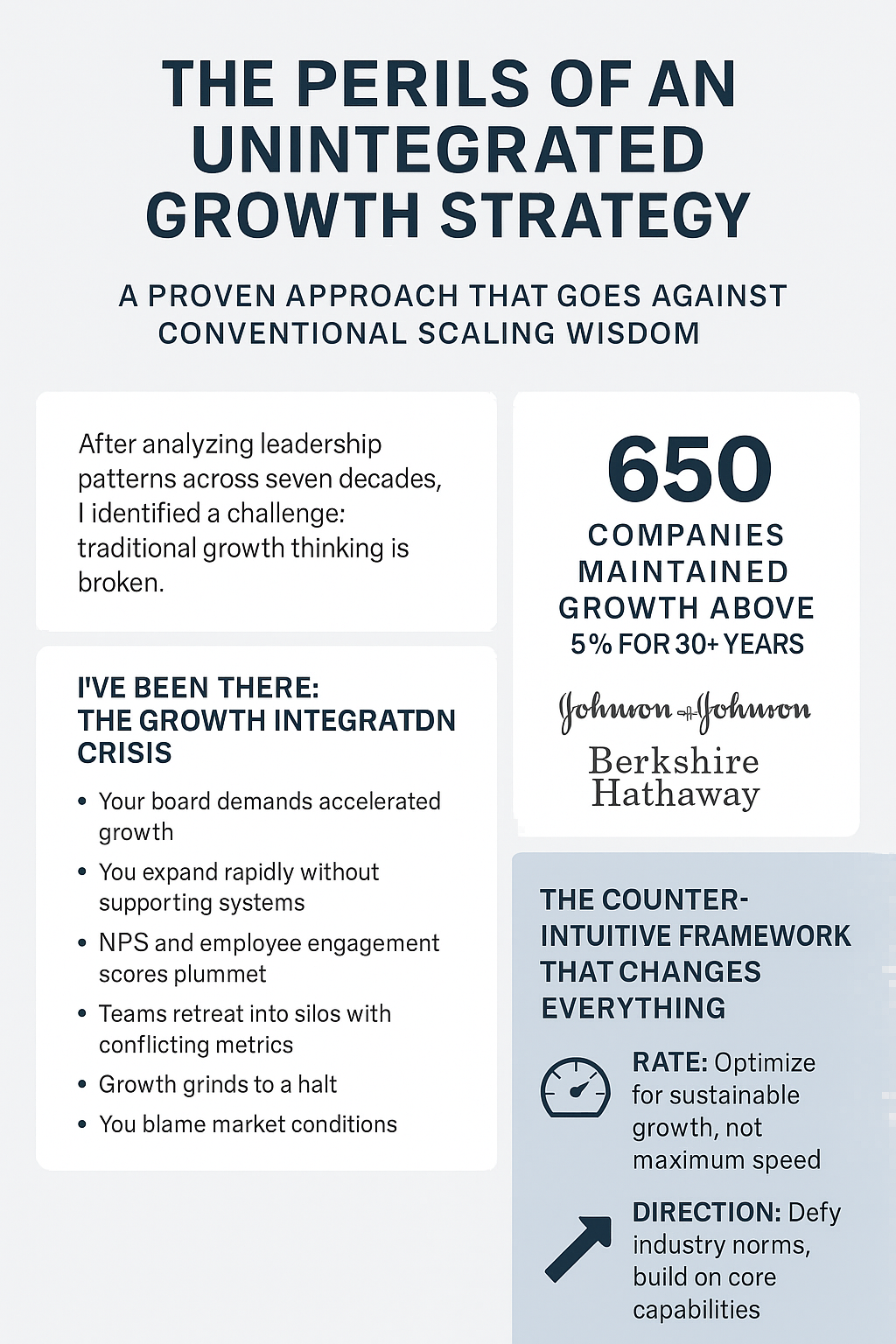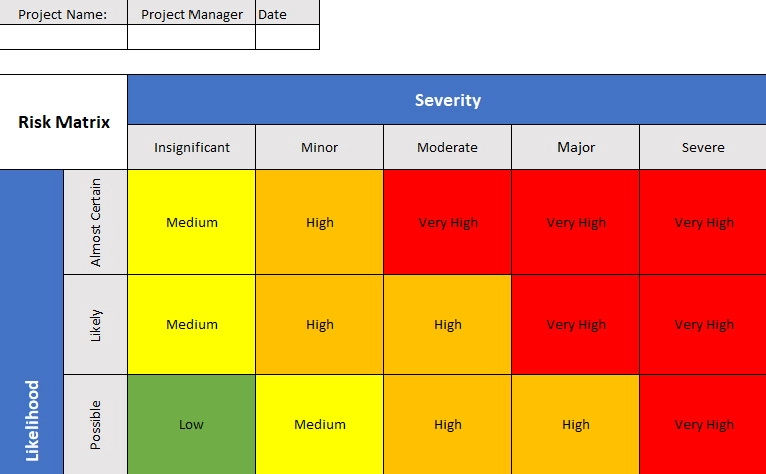The Perils of an Unintegrated Growth Strategy

Why 99% of Companies Fail at Sustainable Growth: The Integration Crisis Nobody Talks About
Discover the counter-intuitive growth framework that helped scale companies from zero to $500M+ while maintaining profitability
After analyzing 11,000 companies across seven decades, a shocking pattern emerged: only 650 maintained growth above 5% for over 30 years. The culprit? A hidden “organizational debt” that sabotages even the most promising growth strategies.
In this data-driven analysis, learn:
Why maximum growth speed actually destroys company value (with real metrics from New Relic and Web.com transformations)
The 3 critical KPIs that predict growth failure before it shows in financial results
The RDM framework that contradicts conventional scaling wisdom but delivers 3x higher profit per location
4 specific actions senior leaders can implement this quarter to build sustainable growth
Drawing from experience leading growth at multiple $1B+ companies through 35+ M&As, this article reveals why companies that deliberately slow growth during uncertainty outperform those maximizing growth rates—and exactly how to implement this counter-intuitive approach in your organization.
Keywords: sustainable business growth, organizational scaling, growth strategy framework, business transformation, leadership strategy, company growth metrics, scaling operations, business integration
The Pitfalls of “Work Family” Culture

In today’s rapidly evolving business landscape, private equity (PE) portfolio companies face a myriad of challenges, including the imperative to integrate cutting-edge AI technologies, meet ambitious business objectives, attract and retain top talent, and seamlessly blend human capital with technological innovations. This article provides an in-depth exploration of how AI can be a transformative force for PE portfolio companies, equipping them with proven strategies to surmount these critical hurdles. Real-world case studies and incisive data analysis will underscore the immense potential of AI to drive success.
Secrets of Success: How High-Performing Teams Work

In today’s fast-paced business environment, the success of an organization often hinges on the performance of its teams. High-performing teams are not just a result of assembling talented individuals but are a product of specific practices, mindsets, and dynamics that foster excellence. Have you ever been in a company where “after meetings” are held after the official meeting, or where everyone knows a project is failing but no one wants to acknowledge it? These are clear indicators of a poorly performing and unhealthy team. This article delves into the secrets of high-performing teams, uncovers common gaps, and offers actionable approaches to elevate team performance. By leveraging these insights, you can transform your team into a powerhouse of productivity and innovation.
Are You a Manager or a Leader? The Difference Matters

In leadership thought and practice, platforms like Thinkers50 stand as pivotal gatherings where today’s foremost thinkers in management share insights that shape the direction of leadership. As the author of “Business Breakthrough,” I had the opportunity to engage in deep discussions with thought leaders like Marshall Goldsmith and Subir Chowdhury, exploring the nuances of what truly makes a leader transformational.
Marshall Goldsmith’s notable work, “What Got You Here Won’t Get You There,” emphasizes the need for leaders to continuously evolve, focusing on proactively identifying and addressing personal blind spots. Subir Chowdhury’s “The Power of Six Sigma” demonstrates how principles of relentless improvement, inspired by Toyota, can be applied to achieve sustained success in organizations as varied as Sony and Lufthansa.
Through my journey from launching startups to leading them to the public market, I’ve seen how innovative approaches can disrupt and outperform the established order. It’s clear that leadership is about more than intellect or charisma; it involves embracing mental models that foster resilience and adaptability. As Marshall suggests, with anonymous feedback, reflecting on past failures to guide future strategies is critical for meaningful progress.
Navigating Leadership Frontiers: Insights from Thinkers50

In leadership thought and practice, platforms like Thinkers50 stand as pivotal gatherings where today’s foremost thinkers in management share insights that shape the direction of leadership. As the author of “Business Breakthrough,” I had the opportunity to engage in deep discussions with thought leaders like Marshall Goldsmith and Subir Chowdhury, exploring the nuances of what truly makes a leader transformational.
Marshall Goldsmith’s notable work, “What Got You Here Won’t Get You There,” emphasizes the need for leaders to continuously evolve, focusing on proactively identifying and addressing personal blind spots. Subir Chowdhury’s “The Power of Six Sigma” demonstrates how principles of relentless improvement, inspired by Toyota, can be applied to achieve sustained success in organizations as varied as Sony and Lufthansa.
Through my journey from launching startups to leading them to the public market, I’ve seen how innovative approaches can disrupt and outperform the established order. It’s clear that leadership is about more than intellect or charisma; it involves embracing mental models that foster resilience and adaptability. As Marshall suggests, with anonymous feedback, reflecting on past failures to guide future strategies is critical for meaningful progress.
Stop The Big Quit. Boost Employee Engagement 30%.

Improve Employee Engagement To Avoid Mass Resignations More than 2/3 of US employees are not actively engaged at work. The Great Resignation is here. We might not agree on what to name it, but whether we call it The Great Contemplation, The Great Upgrade, The Great Reimagination (or many more), there’s no question the workplace […]
Boost Your Enterprise Agility With “The Three Rs”

In the first article in this series, I made the case for enterprise agility – not just saying you’re a digital business but truly operating like one. It means that throughout your organization, teams accept change, drive towards acceleration and are comfortable with ambiguity.
The Importance of Building a Risk Management Matrix

It doesn’t matter if your company is in the Fortune 100 or a small business that you operate from your home, Risk Management needs to be an integral part of your daily considerations to run a profitable business. Of course, depending on your size and scope there will be different factors that need to be considered. A multi-national company needs to focus on different risk factors than a “mom and pop” business. For example, a large company